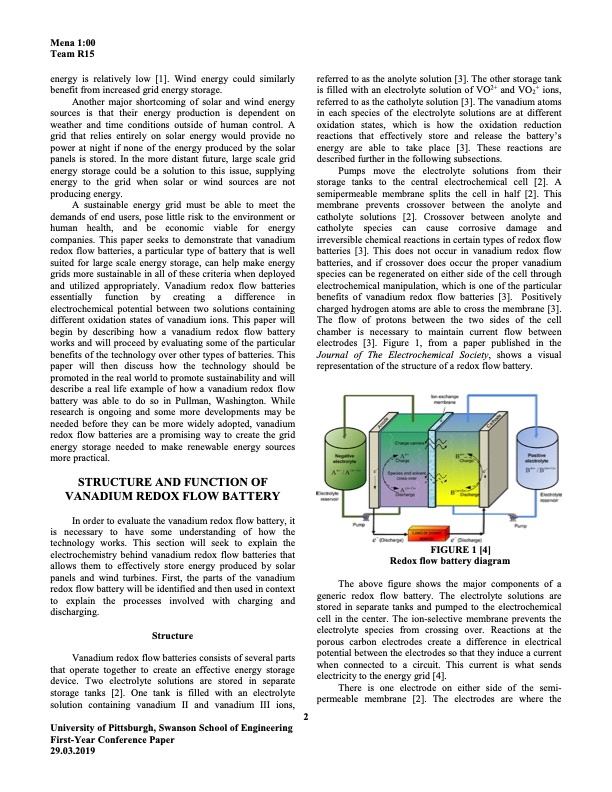
PDF Publication Title:
Text from PDF Page: 002
Mena 1:00 Team R15 energy is relatively low [1]. Wind energy could similarly benefit from increased grid energy storage. Another major shortcoming of solar and wind energy sources is that their energy production is dependent on weather and time conditions outside of human control. A grid that relies entirely on solar energy would provide no power at night if none of the energy produced by the solar panels is stored. In the more distant future, large scale grid energy storage could be a solution to this issue, supplying energy to the grid when solar or wind sources are not producing energy. A sustainable energy grid must be able to meet the demands of end users, pose little risk to the environment or human health, and be economic viable for energy companies. This paper seeks to demonstrate that vanadium redox flow batteries, a particular type of battery that is well suited for large scale energy storage, can help make energy grids more sustainable in all of these criteria when deployed and utilized appropriately. Vanadium redox flow batteries essentially function by creating a difference in electrochemical potential between two solutions containing different oxidation states of vanadium ions. This paper will begin by describing how a vanadium redox flow battery works and will proceed by evaluating some of the particular benefits of the technology over other types of batteries. This paper will then discuss how the technology should be promoted in the real world to promote sustainability and will describe a real life example of how a vanadium redox flow battery was able to do so in Pullman, Washington. While research is ongoing and some more developments may be needed before they can be more widely adopted, vanadium redox flow batteries are a promising way to create the grid energy storage needed to make renewable energy sources more practical. STRUCTURE AND FUNCTION OF VANADIUM REDOX FLOW BATTERY In order to evaluate the vanadium redox flow battery, it is necessary to have some understanding of how the technology works. This section will seek to explain the electrochemistry behind vanadium redox flow batteries that allows them to effectively store energy produced by solar panels and wind turbines. First, the parts of the vanadium redox flow battery will be identified and then used in context to explain the processes involved with charging and discharging. Structure Vanadium redox flow batteries consists of several parts that operate together to create an effective energy storage device. Two electrolyte solutions are stored in separate storage tanks [2]. One tank is filled with an electrolyte solution containing vanadium II and vanadium III ions, 2 University of Pittsburgh, Swanson School of Engineering First-Year Conference Paper 29.03.2019 referred to as the anolyte solution [3]. The other storage tank is filled with an electrolyte solution of VO2+ and VO2+ ions, referred to as the catholyte solution [3]. The vanadium atoms in each species of the electrolyte solutions are at different oxidation states, which is how the oxidation reduction reactions that effectively store and release the battery’s energy are able to take place [3]. These reactions are described further in the following subsections. Pumps move the electrolyte solutions from their storage tanks to the central electrochemical cell [2]. A semipermeable membrane splits the cell in half [2]. This membrane prevents crossover between the anolyte and catholyte solutions [2]. Crossover between anolyte and catholyte species can cause corrosive damage and irreversible chemical reactions in certain types of redox flow batteries [3]. This does not occur in vanadium redox flow batteries, and if crossover does occur the proper vanadium species can be regenerated on either side of the cell through electrochemical manipulation, which is one of the particular benefits of vanadium redox flow batteries [3]. Positively charged hydrogen atoms are able to cross the membrane [3]. The flow of protons between the two sides of the cell chamber is necessary to maintain current flow between electrodes [3]. Figure 1, from a paper published in the Journal of The Electrochemical Society, shows a visual representation of the structure of a redox flow battery. FIGURE 1 [4] Redox flow battery diagram The above figure shows the major components of a generic redox flow battery. The electrolyte solutions are stored in separate tanks and pumped to the electrochemical cell in the center. The ion-selective membrane prevents the electrolyte species from crossing over. Reactions at the porous carbon electrodes create a difference in electrical potential between the electrodes so that they induce a current when connected to a circuit. This current is what sends electricity to the energy grid [4]. There is one electrode on either side of the semi- permeable membrane [2]. The electrodes are where thePDF Image | VANADIUM REDOX FLOW BATTERIES FOR GREEN ENERGY

PDF Search Title:
VANADIUM REDOX FLOW BATTERIES FOR GREEN ENERGYOriginal File Name Searched:
c11-vanadium-redox-flow-batteries.pdfDIY PDF Search: Google It | Yahoo | Bing
Salgenx Redox Flow Battery Technology: Salt water flow battery technology with low cost and great energy density that can be used for power storage and thermal storage. Let us de-risk your production using our license. Our aqueous flow battery is less cost than Tesla Megapack and available faster. Redox flow battery. No membrane needed like with Vanadium, or Bromine. Salgenx flow battery
| CONTACT TEL: 608-238-6001 Email: greg@salgenx.com | RSS | AMP |